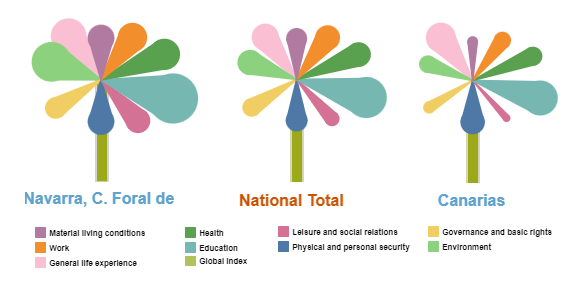

Multidimensional Quality of Life Indicator (MQLI)
Main results
- Quality of life in Spain increased slightly in 2023.
- Work, Education, Environment and general life experience improved their scores compared to 2022. On the contrary, Material living conditions, Health, Leisure and social relations and Physical and personal security worsened.
- Comunidad Foral de Navarra, La Rioja and Aragón had the highest levels of quality of life in 2023.
More information
Quality of life in Spain increased in 2023. The Multidimensional Quality of Life Indicator (MQLI) stood at 101.54 points, compared with 101.40 the previous year.
Dimensions of the national MQLI
The increase in the MQLI in 2023 was driven by the dimensions Work, Education, Environment and General Life Experience. On the contrary, the score of Material living conditions, Health, Leisure and social relations and Physical and personal security worsened compared to the previous year.
The Governance and basic rights dimension was maintained, as it was not updated because the triennial Quality of Life module was not included in the 2023 Living Conditions Survey.
Results by Autonomous Communities
Comunidad Foral de Navarra, La Rioja and Aragón presented the highest levels of quality of life in 2023, as was the case in the previous edition.
On the other hand, the lowest levels were in Canarias, Galicia and Andalucía.
Compared to 2022, Comunidad Foral de Navarra experienced a decrease of 0.24 points in the level of quality of life, while Canarias increased it by 0.4 points.
MQLI dimensions by Autonomous Community
If we analyse the new dimensions separately in the Autonomous Communities, Comunidad Foral de Navarra stood out in the dimensions: Health, Leisure and social relations, Surroundings and the environment, and General experience of life. País Vasco stood out for Material living conditions and Education.
Meanwhile, Illes Balears stood out in Work, Principado de Asturias in Physical and personal security and Comunitat Valenciana in Governance and basic rights.

Revision and updating of data
The results published in previous years may undergo alterations due to the methodology of the statistics. There is a process of standardisation in drawing up the indices whereby the value is re-scaled to have comparable ranges in the different indicators. The time series of the indicators is used in this standardisation, taking the maximum and minimum of the indicator in all the Autonomous Communities and periods. Thus, when data are incorporated from a new year, the indices of the whole period may be affected. Moreover, some indicators of the series may be revised if there has been an update. All results of this operation are available on INEbase.
Methodological note
The MQLI consists of the construction, on an experimental basis, of an indicator to consolidate information from the INE's Quality of Life Indicators (QLI). These indicators offer a panoramic (multidimensional) overview of the quality of life in Spain.
The MQLI is calculated nationally and by Autonomous Community. The process of aggregating individual indicators for each autonomous community is carried out in two steps: first, the indicators that represent a dimension are aggregated into a single indicator of the dimension using the AMPI method. Secondly, these nine indicators are added in a single MQLI and this aggregation, by default, is done with all dimensions equally weighted; however, the user can interact with the system and choose a different weighting, giving more or less importance according to the user’s judgement to one or another aspect of the quality of life.
Altogether, 55 indicators are involved in the calculation of the indicators, although not all are updated annually. In this edition, eight of the nine dimensions have been updated.
- Statistic type:
- Experimental, annual.
- Population scope:
- the indicators come from various sources. They generally refer to the population resident in Spain.
- Geographical scope:
- the entire national territory. Data are offered by autonomous communities.
- Reference period:
- since this is a statistic that combines a multitude of sources, each of the indicators has a different reference period. The most current indicators, which are the majority, refer to the year 2023.
More information in the technical project.
INE statistics are produced in accordance with the Code of Good Practice for European Statistics. More information on Quality at INE and the Code of Best Practices.
 Official INE account on
@es_ine
Official INE account on
@es_ine
- All press releases at:
- www.ine.es/en/prensa/prensa_en.htm
- Press office:
- (+34) 91 583 93 63 / 94 08 – gprensa@ine.es
- Information area:
- (+34) 91 583 91 00 – www.ine.es/infoine/?L=1
